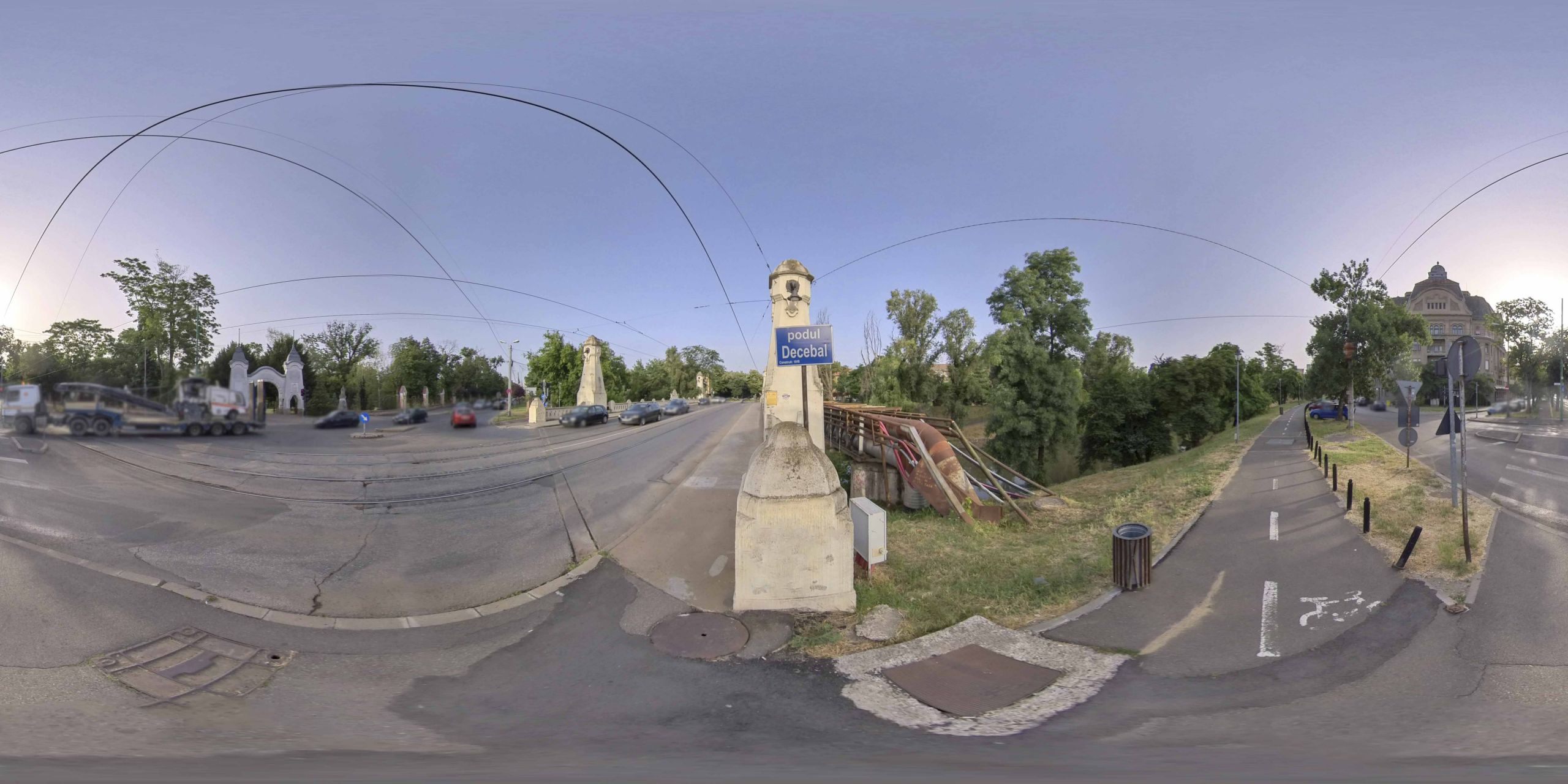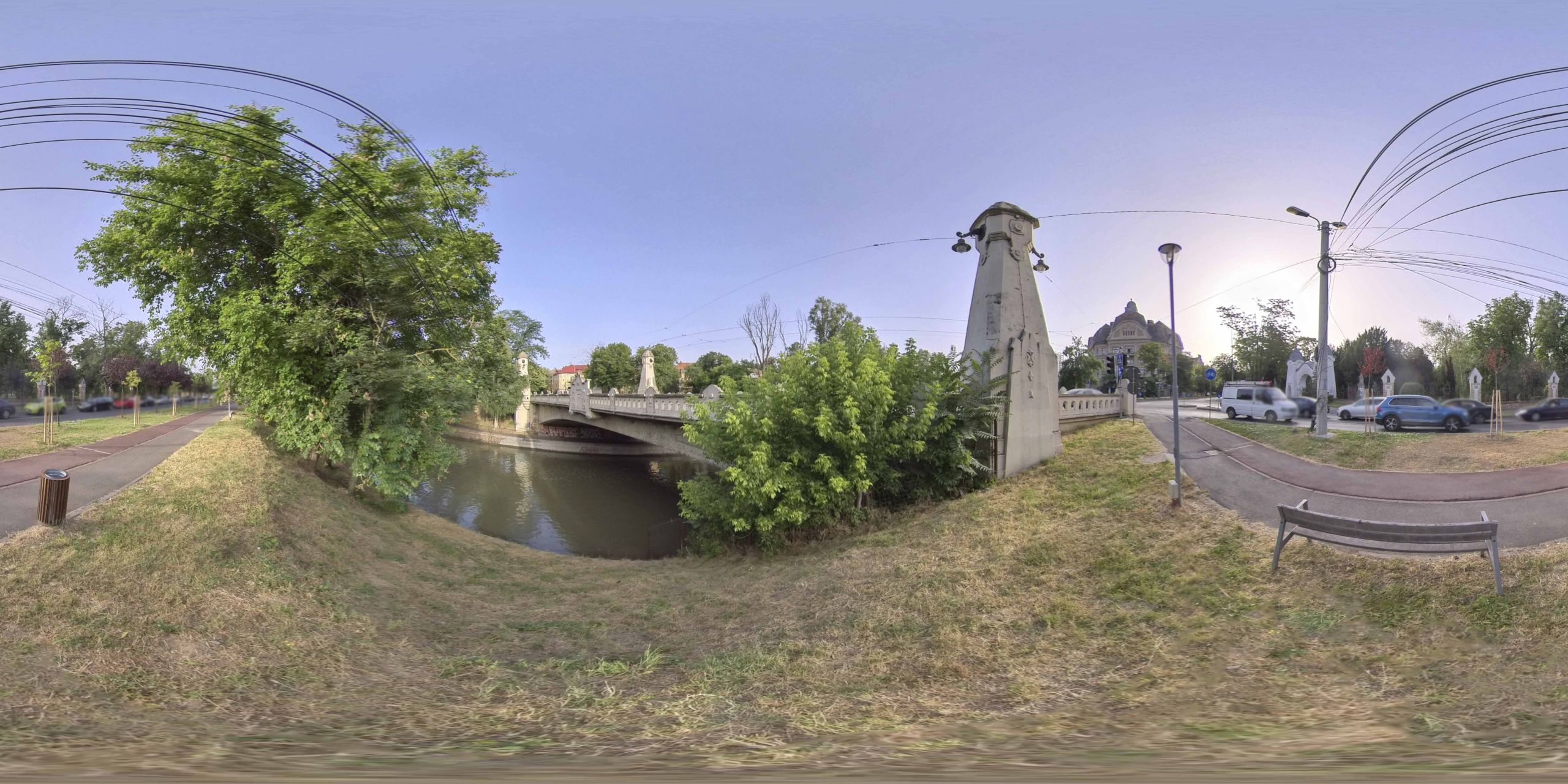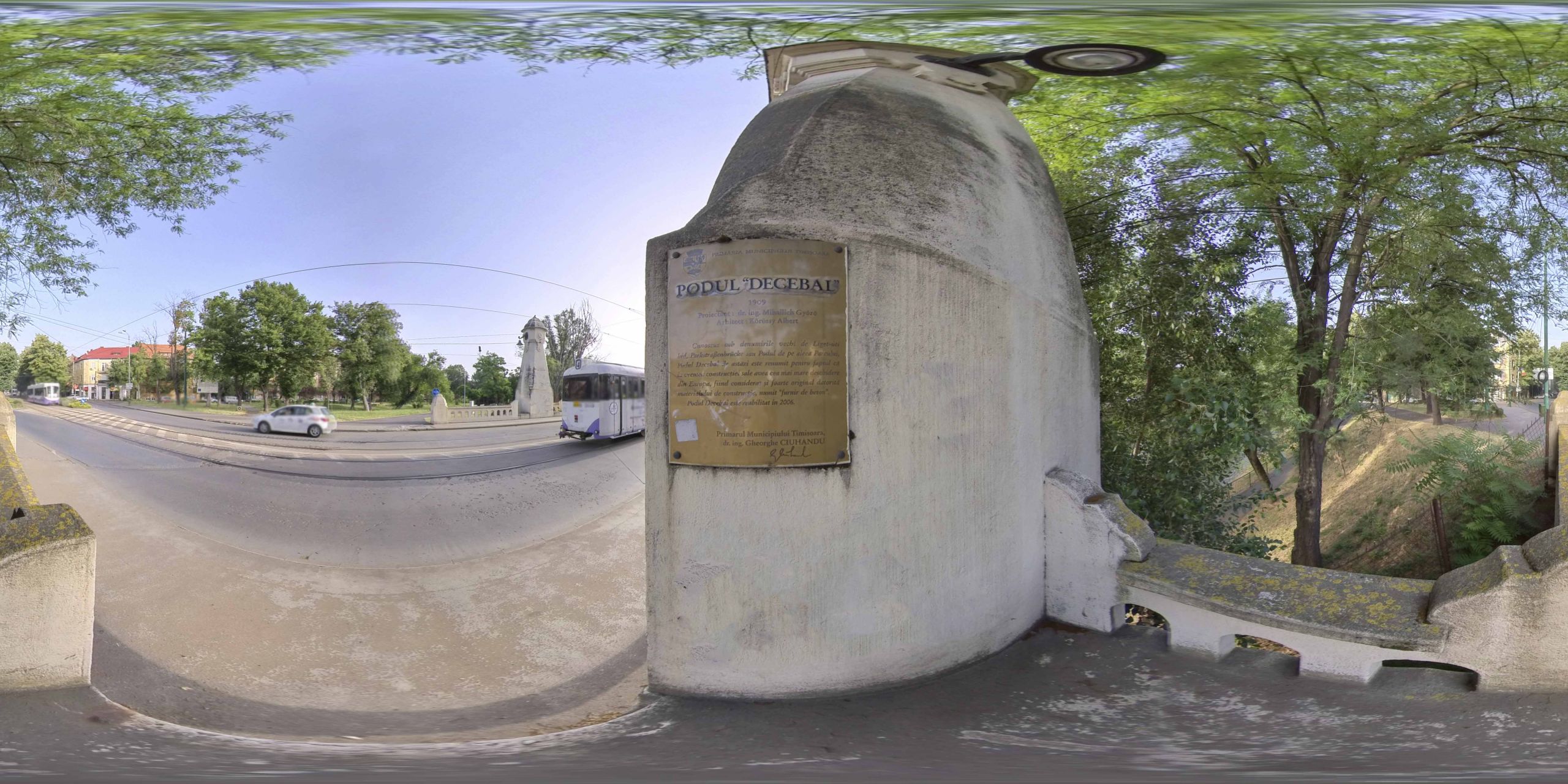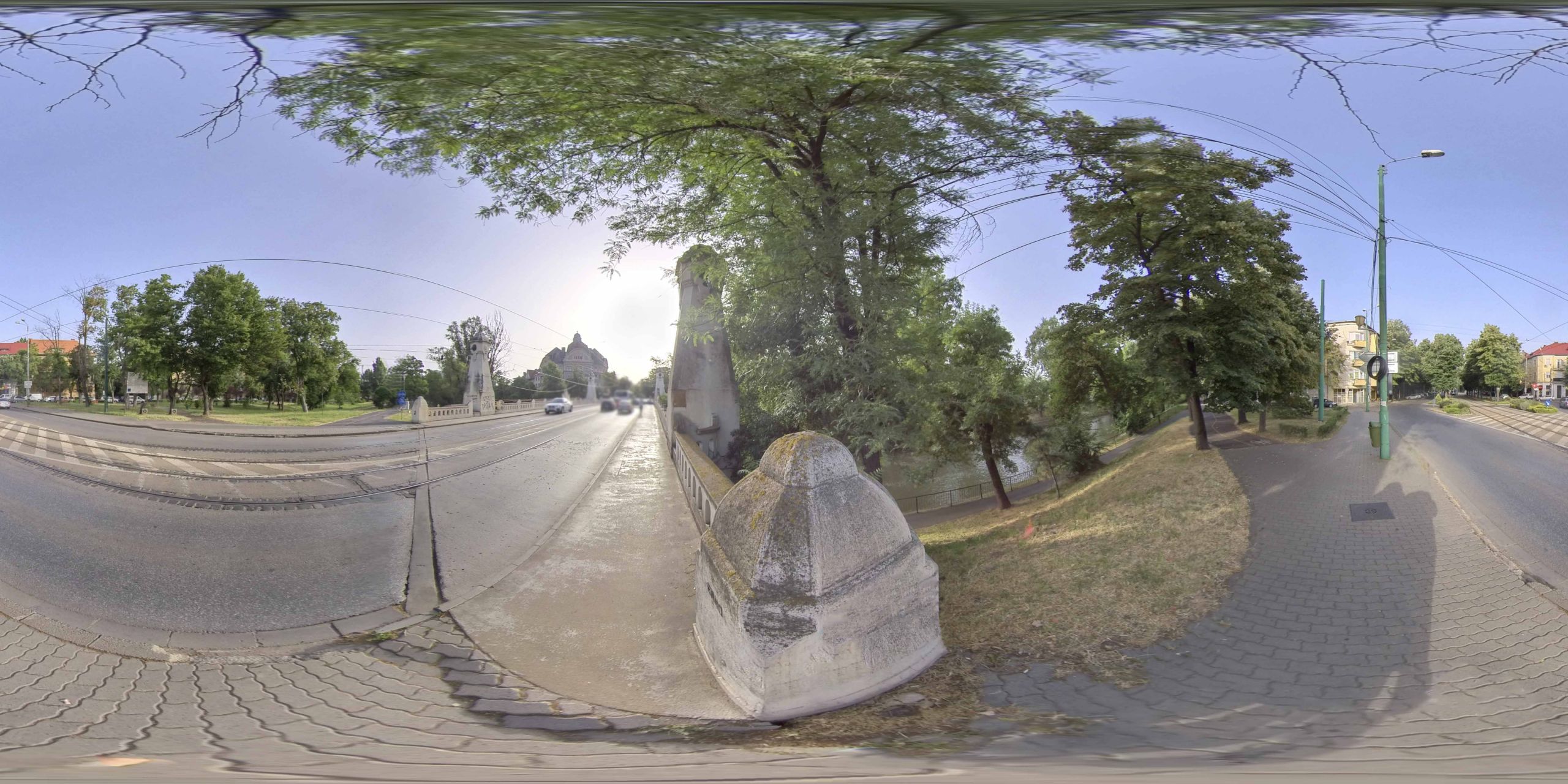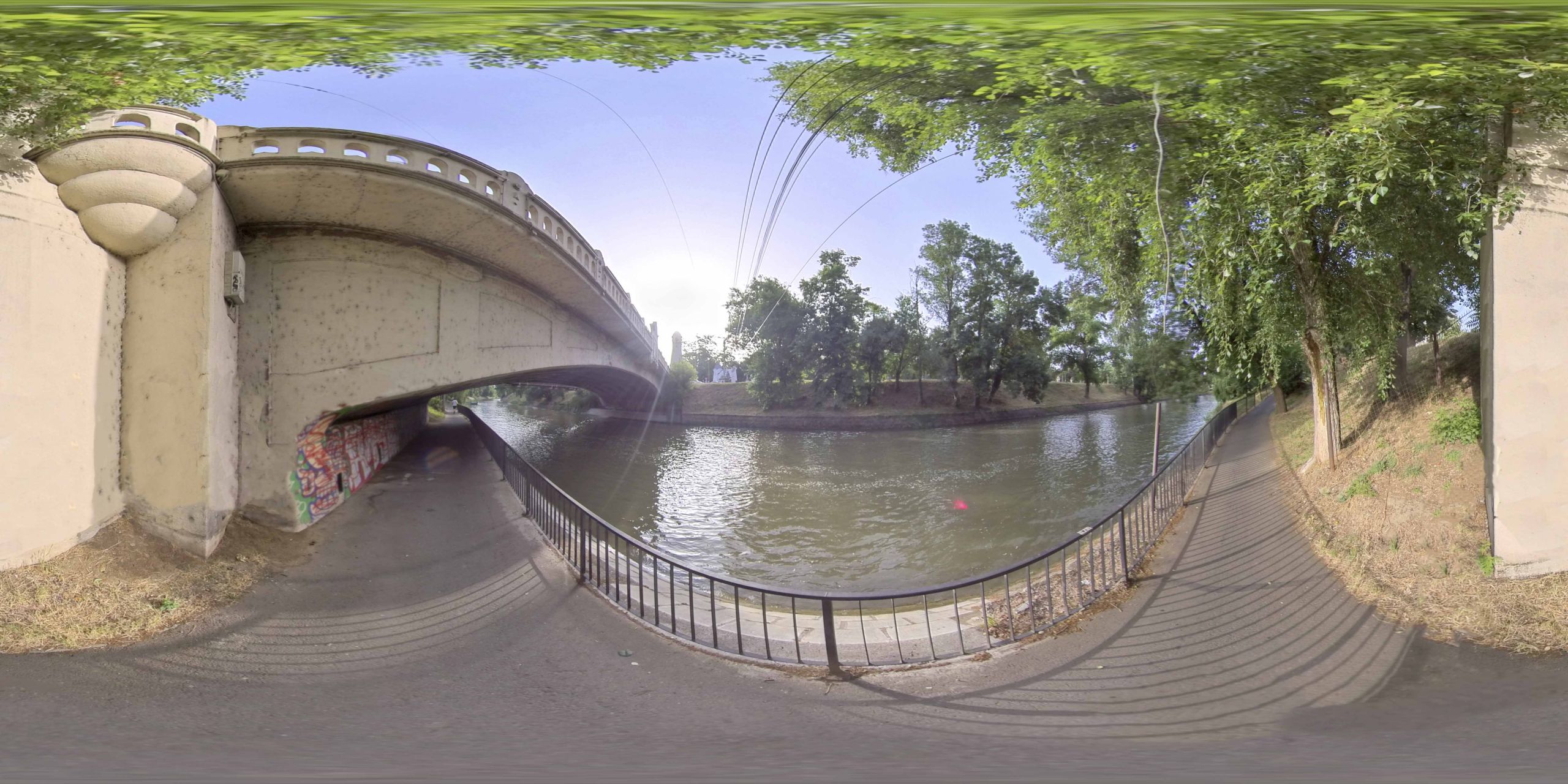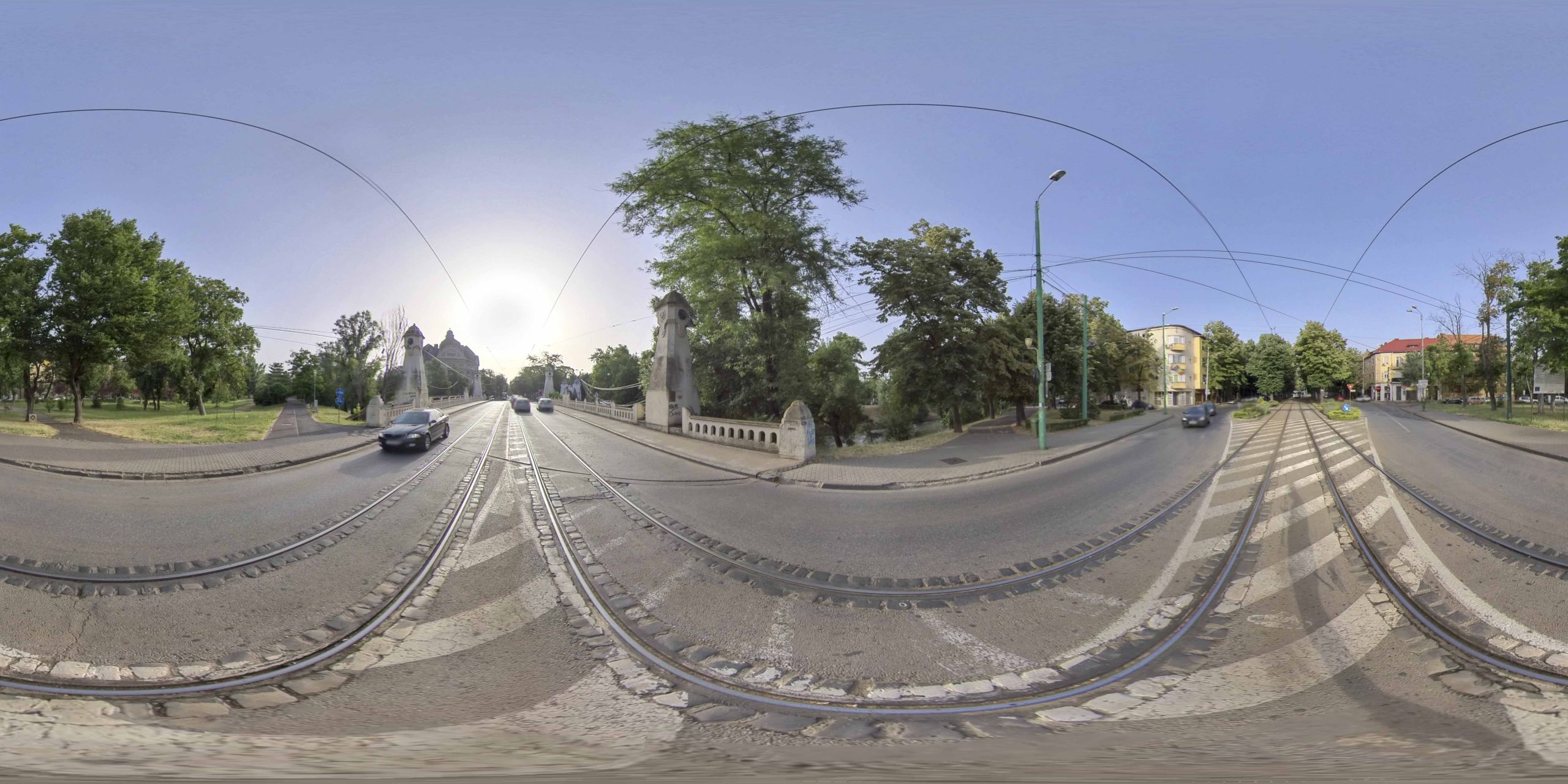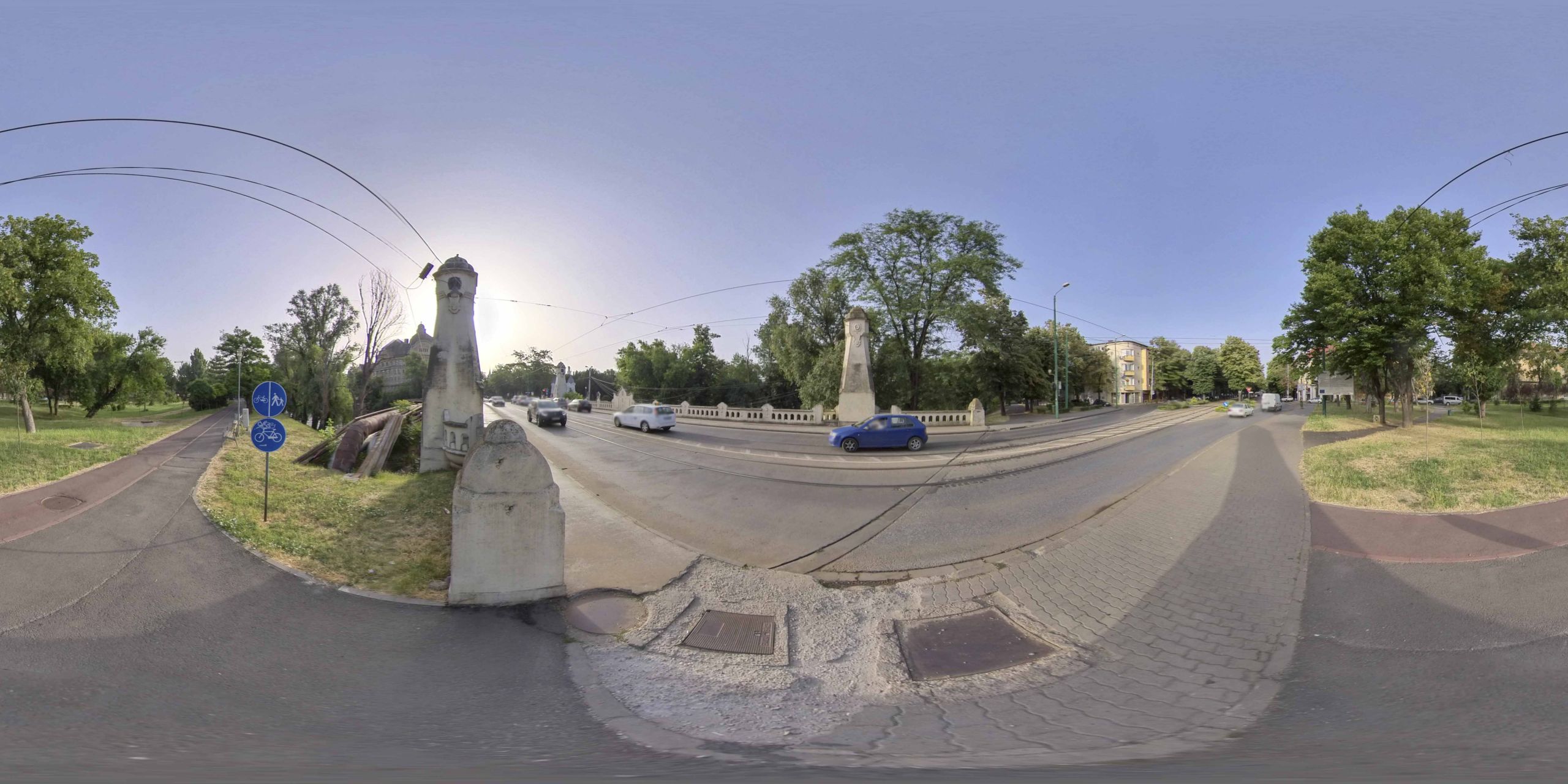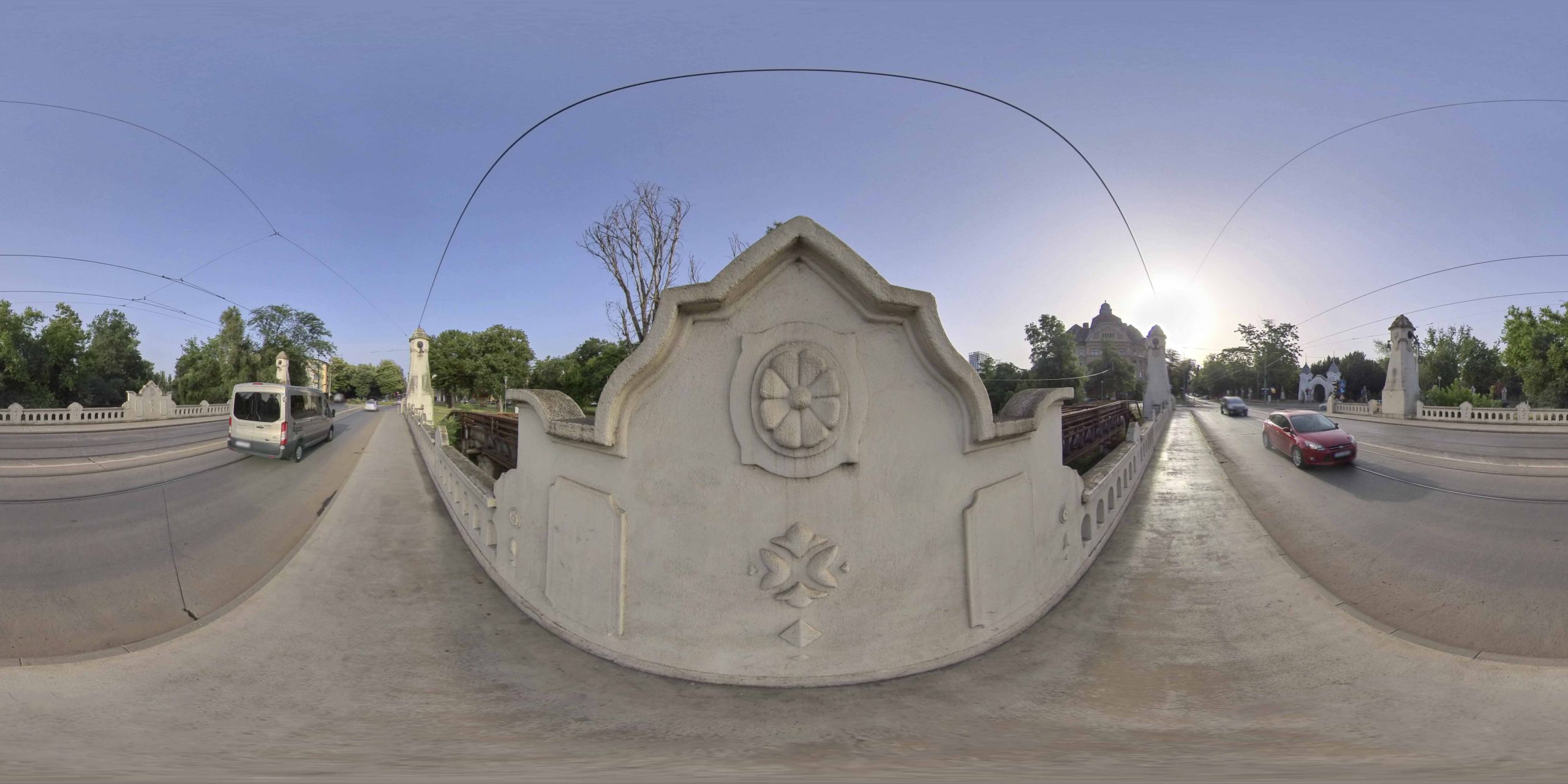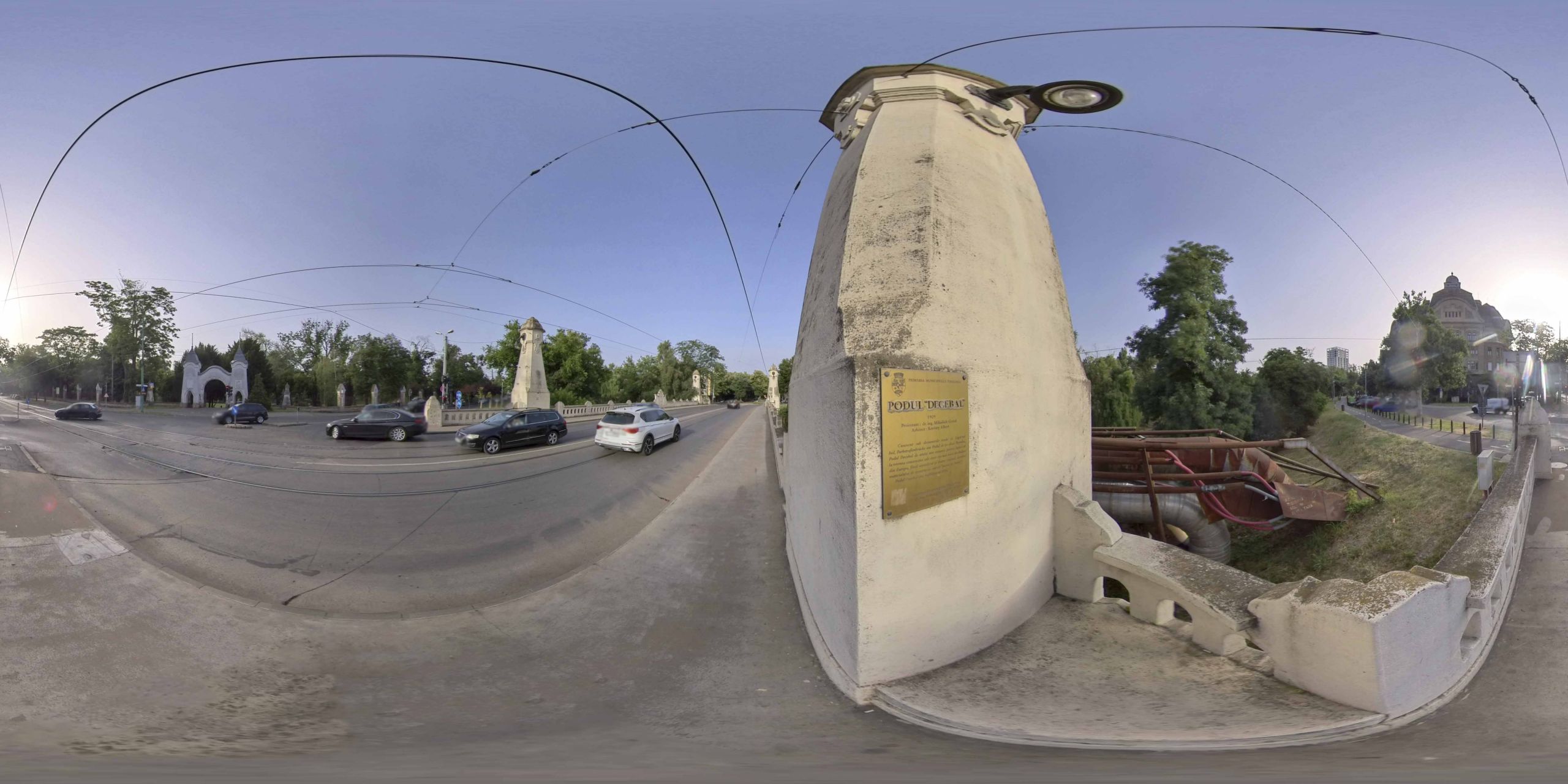Decebal Bridge, Bd. Revolution of 1989 - Bd. 3 August 1919
The construction of the Decebal bridge, the longest bridge on reinforced concrete beams in Timișoara, at that time, began in 1908, being completed a year later.
Listen to the audio version.
Decebal Bridge (formerly Liget-úti hid; Parkstraßenbrücke, Park Alley Bridge), known as the Neptun Bridge, was designed by Mihailich Gyözö, the architect of the bridge being Körössy Albert. Construction of the bridge began in 1908 and was completed a year later. Prior to the regularization and excavation of the new canal, near this location was the raft canal, which was crossed by a wooden bridge.
Given the fact that the requirements of the City Council regarding the framing of the bridges in the environment were very strict, not allowing too high a construction height, and the fact that the width of the Bega canal was considerable, an innovative solution was needed to ensure compliance with all parameters imposed.
In this context, the solution of the beams with consoles was used. At that time, this technical solution was considered bold, because until then no bridges were built on reinforced concrete beams with such an opening. The achievement was all the more remarkable as, in the area of maximum positive moments, the requirements imposed a minimum construction height.
Professor Mihailich Gyözö solved the problem by using seven articulated beams with three openings. Thus he managed to diminish the positive moments in the central opening. The marginal supports were designed in the form of pilots, the two marginal openings being drowned in the embankment. Thus, it was no longer necessary to build classic abutments, ensuring a considerable financial economy.
The innovative nature and the fact that it had an opening of 11 + 38, 42 + 11 meters made this bridge to be the longest bridge on reinforced concrete beams, at that time, ensuring its notoriety, thus being mentioned in several papers in its field.
Bibliography:
Jancsó Árpád, The History of Bridges in Timișoara, Mirton Publishing House, Timișoara, 2001.
We turned into Ofcea Street and shouted to those who were on the balconies “Romanians, come with us!”, “You are Romanians, too!”. Then, we reached V. Pârvan Boulevard and Decebal Bridge, on the alley that separates the People’s Park from the Bega Canal. From the fence to the Bega, it was packed with protesters holding hands. There were over 10,000 protesters. When we were about to make a turn on Decebal Bridge, all the lights in the neighborhood, behind and ahead of us, went out and so we marched on in the dark. Some said we were going to the County Council, others thought they were going to the Police Station for the release of those who had been detained the previous night, December 16 to 17, when many people had been arrested. The armed forces were there on Decebal Bridge: border guards, soldiers. There were also two tanks and another military vehicle blocking the passage. When I saw that we couldn’t go any further, I shouted again: “No violence!” “Soldiers, , soldiers, who are you defending?”, “The army is with us!” but they started firing, this time with real bullets and no warning: they fired right at us.
Only when the first ten rows of protesters in the front fell, I did realize they were shooting us. We were fully exposed, and we saw sparks coming out of the stones on the ground and from the pillars.
I was somewhere on the sidewalk, on the right, and the first thing I did was to grab my wife so that we could hide behind the concrete pillars of the fence on the right, but as we were heading for the fence, my wife (Leontina Bânciu) fell, holding my arm. I leaned over her and asked: "Where did it hit you?” and she said: "“I don’t know, I don’t know.”
Ioan Bânciu – excerpt from an interview by Roxana Pătraşcu, Timişoara 1997, The oral history and anthropology group archive, coordinated by Smaranda Vultur.
Leontina Bânciu, shot in December 1989, disappeared along with the 55 victims secretly transported from the Timiș County Hospital to the Crematorium in Bucharest on the night of December 18-19. Former Narciselor Street now bears the name of Leontina Bânciu, martyr of the Revolution, and the sculptor Peter Jecza created the work Mercy , placed in front of the Neptun Baths as a tribute to her memory.
On the Bega: From the Decebal Bridge to the Mihai Viteazu Bridge
You started the story of a character, you said famous, from the Fabric neighborhood...
… Yes, he was famous in those years, the 50s and 60s, a teamster, a coachman, , his name was Mutu (Voiceless), he really suffered from this disability, he frequently executed, in the middle of summer, his number of great attractions for all passers-by - children, young, old - who were on their way, were passing through that place. It was always, from morning to evening, a real human mess there... I mean, again, the Hay Market. Or Badea Cârțan Square. Well, Mutu (Voiceless), he was jumping off the bridge, from here... From the bridge from Badea Cârţan to Traian Square. He jumped feeş into Bega, on his head with his arms forward, stretched perfectly, and, as I say, was a number of great attraction. It was still hot. But the summers were healthier, more bearable than they are now. It wasn't as polluted as it is now. The heat was scorching, we walked and ran all day, barefoot, we children, on the asphalt, our feet were well beaten... It's true, car traffic was much lower. And then, as I say, we were children, we were young…
Continue with the character...
Yes, he was voiceless. Sure, he spoke by signs. I know he was a native German, a Hungarianized German, a picturesque figure - he looked like a Viking. After a few years, I compared him, imaginatively, with the famous Johnny Weismüller, from the interwar Freidorf. We consider him a Johnny Weismüller of Fabric, from that period of my childhood. He received, I think I remember well, five pennies, sometimes 10 pennies, from passers-by and, as a reward, he offered us that show which he repeated, if I don't know how many times, for and to everyone's delight. Namely: the jump from the bridge, in the head, feeș, , as it was said, then, with a Hungarian word. He jumped into Bega and the people crowded there, fascinated, above the bridge to see this test of courage, but also of mastery, so to speak. Of course, the show was accompanied, non-stop, by a flood of applause, which he probably perceived without hearing. And he, the Voiceless, was a big fan of Scandenberg. He usually provoked the most handsome, the most muscular, the young at a Scandenberg. I remember that he provoked me too and the culmination is that I managed to put him down with my left hand (laughs)...
At what age?
At... I think I was already about fourteen, fifteen. And, of course, I was fascinated by those exercises of strength... All generations have, how can I say, idols and they have, speaking of teenagers, of boys, they have this hypnosis of strength, of muscles, and then, of course, that you are trying to become a little character, a little hero of the street where you live... By the way, I tell you, at about the same time, boxing was also practiced, it had even become a fashion of the time among neighborhood boys...
Where? On the street?
No, no... Sure, on the street too... But it was already a fight, a "caft" in the hard way. And dumbbells were practiced, these strength sports. Or pull-ups. For such tractions, they used the frequencies, at that time, carpet beaters... because they were very practical to display or cultivate, so to speak, a certain shape and strength of the body... It was of great effect, as a guy, as a teenager, such a show of strength, towards the little ones and, of course, towards the admiration of the girls, of the girls in the neighborhood. In general, molded T-shirts were worn on the body, highlighting the shape and roundness of the muscles.
(...) There were sports clubs, though. There was, for example, the ILSA club, with several sports sections... There was also a swimming pool, where I learned to swim, at ILSA, but also at Bega, without a teacher and without a coach, as the older ones taught us. They would throw us into the water and eventually tie us with a rope or something, with a cord, and when we swallowed too much water, they would somehow bring us to the surface and pull us ashore. At ILSA, there was a small boxing department where I also practiced sports with ... gloves for a while, but not too much, because my father found out, a severe man, and I know he forbade me. I secretly continued to train after that, but not for long, because I don't know if I had a vocation, necessary in this sport, of toughness, although - I was told - it seems that talent, I had technical skills and even courage... But I liked it, just like that, as a teenage hobby ... It was a seduction of something that woke you up to put yourself, so to speak, face to face with yourself, in the sense that you need, from time to time, to prove that you can be brave, that you can even endure some physical blows, without being terrified by fear, dread... Because there is, especially in those very young years, there was even then, an attraction for such things as terrible as possible, as terrible as they are, so to speak. It also exists in today's children, these hard or contact sports as they are called, have appeared. There were also clubs at the U.M.T., there at the Green Forest. A boxing club where many friends from the neighborhood were boxing so that they could defend themselves or become aggressive themselves, in their turn... I flirted too, I repeat, for a while, with boxing training... of course at amateurs. At one point, I had, for a while, as a coach, if I remember correctly, Ambruş Bacsi, as he was called, a coach with a certain status, and even fame in the world of boxing in Timisoara of those years. He was middle-aged, Baci was a nickname used by those who were past their prime youth... A word, obviously, also of Hungarian origin. I must add that, at that time, Fabric had given some great boxers of national size. I remember two or three names: Bidl Maximilian, Pazmany, the Picior brothers, then Schubert, Șubi as he was called, a former colleague, younger, from high school... He had been, at one point, even a champion, if I'm not mistaken, in the heavy category.
Eugen Bunaru, born in Timişoara in 1945 - excerpts from the interview conducted by Aurora Dumitrescu in 2004, Timişoara. Archive of the Oral History and Cultural Anthropology Group, coordinated by Smaranda Vultur.
On the banks of the Bega
It was an interesting life there near Bega, something always happened. Either a dead man was pulled out of Bega, a corpse, or a horse or a cow fell into the water. What a circus it was until it took them out. And... a cart. A buffalo entered the water with a cart. You realize what a mess it was until it got her out of there. Across the street was a garden with fruit trees. And there were some sour cherries or cherries and someone went there. And on the side of our house came a waiter from the restaurant, he was well dressed, in black, but he was a little drunk. And that one shouted from the other side, "Do you need cherries?" "Yes, yes, yes!" "Come down here." As he was drunk, he walked down there. Here in Fabric, you know what the shore of Beghe is like from Neptune onwards. And they took a basket with twigs and she was in a bathing suit, she swam with the basket in her hand to the edge. And he, with his tailcoat, knelt on the edge to lift it up and fell inside (laughs). What a circus it was, he didn't know how to swim and he was afraid. Then two, three jumped after him, and in the past, there were these stairs, every hundred meters there were stairs, until they pushed him there, he swallowed water, what a circus it was with them. Some events. Look, when the Russians were here, I came home later: it was dangerous at the time. "Davai clock!"and others. And next to us was a street coming from the Water Tower to Bega. And we sat near, at the corner. And when I get to the door, I hear an American jeep coming with Russians. And there were four Russians, they didn't know Bega was there. And straight, straight, they thought... There was still the street forward, but there was no bridge. And they came to the edge, and it was just a light mound, the car jumped so high and straight into Bega, with four Russians. They sank, the car disappeared... The command was announced...
Frederic König, born in 1910 in Timișoara - excerpt from the interview conducted by Aurora Dumitrescu in Timișoara in 1998, Smaranda Vultur (coord.), published in “Lumi în destine”, Nemira Publishing House, Bucharest, 2000.
